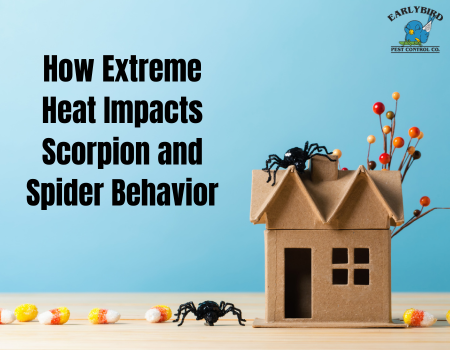If you live in Arizona, you’re no stranger to seeing a scorpion skitter across your patio or a spider tucked away in a cool corner. But have you ever wondered how the desert’s intense heat affects their behavior? As temperatures climb, scorpions and spiders don’t just survive, they adapt, moving, hunting, and hiding in ways that might surprise you. Understanding these patterns is key to managing pests safely and effectively throughout the year.
How Scorpions React to Heat
Scorpions are true desert survivors. In Arizona’s extreme climate, they’ve evolved to handle scorching days and cooler nights. However, when summer temperatures push beyond 100°F, even these heat-hardened creatures look for relief.
During the day, scorpions retreat into cool, dark hiding spots—under rocks, wood piles, and even inside homes. The hotter it gets, the deeper they burrow or the more frequently they sneak indoors to escape the sun. This is why many homeowners notice an increase in scorpion sightings during midsummer evenings.
At night, when the temperature drops, scorpions become more active hunters. They rely on the desert’s cooler air to conserve energy and seek prey like crickets, roaches, and other insects. If your yard has consistent water sources, lush landscaping, or debris piles, it’s an open invitation for scorpions seeking both food and shelter.
How Spiders Handle Arizona’s Climate
Spiders also adjust their habits in response to the desert’s heat, though in slightly different ways. Many Arizona spiders like the common house spider, black widow, and wolf spider, thrive in shaded, sheltered environments. When outdoor temperatures rise, they often move indoors, into garages, crawl spaces, and shaded corners where it’s cooler and prey is abundant.
High heat doesn’t kill most spiders, but it does drive them to seek stability. They look for spots with consistent temperature and humidity. In older homes or poorly sealed structures, these spiders can easily find entry points.
Interestingly, some species become more aggressive in their hunting during the hot months, driven by higher metabolic rates. Others may slow down to conserve moisture. These behavioral shifts mean pest control efforts need to adapt depending on the season.
The Heat-Hiding Cycle: Why You See More in Summer
Many homeowners assume summer heat kills pests, but the opposite often happens. The hotter it gets, the more these creatures invade cooler spaces like homes, sheds, and garages. Both scorpions and spiders are nocturnal, so while the daytime may seem quiet, nighttime brings activity.
From June through September, pest control companies in Arizona typically see spikes in service calls due to these behavioral patterns. But that doesn’t mean the problem disappears in winter. As the temperature drops, scorpions and spiders seek warmth, often settling inside walls or attics, waiting for spring.
Year-Round Prevention Tips
1. Seal entry points. Use weatherstripping, caulking, and fine mesh screens around vents and doors to keep pests out.
2. Reduce outdoor clutter. Wood piles, debris, and overgrown vegetation create perfect hiding spots.
3. Manage moisture. Both spiders and scorpions seek water. Fix leaky faucets and eliminate standing water.
4. Control indoor humidity. Use dehumidifiers in basements and storage areas.
5. Regular pest control treatments. Consistent professional maintenance helps break the pest life cycle and reduce infestations.
The Big Picture
Arizona’s heat shapes the life patterns of its most resilient pests. Scorpions and spiders are not just random intruders—they’re reacting to environmental cues, moisture levels, and temperature shifts. Knowing this helps homeowners make smarter decisions about prevention and control.
Extreme heat doesn’t eliminate pests—it changes their behavior. By understanding when and why they move, you can stay one step ahead, keeping your home a safe and comfortable space year-round.


Recent Comments